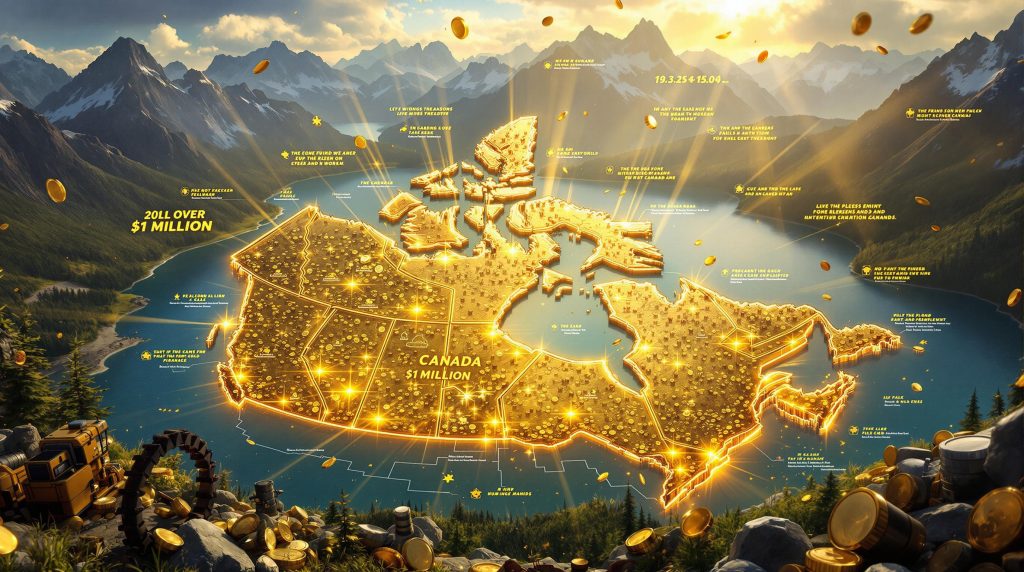The Northern Miner's Million-Dollar Gold Treasure Hunt: Canada's Ultimate Mining Adventure
The Northern Miner has launched one of Canada's most ambitious treasure hunts, capturing the imagination of adventure seekers and mining enthusiasts alike. With over $1 million in physical gold hidden across the country, this nationwide challenge combines problem-solving, mining knowledge, and the thrill of discovery in a unique format that pays homage to Canada's rich mining heritage.
What Is The Northern Miner's Gold Treasure Hunt?
The Basics of Canada's Million-Dollar Mining Challenge
The Northern Miner treasure hunt in Canada represents a groundbreaking adventure featuring over $1 million in physical gold hidden throughout Canada. Launched in August 2023, it stands as one of the country's largest public treasure hunts ever organized, offering participants the chance to win substantial prizes while learning about Canada's mining industry.
The treasure hunt includes 12 monthly prizes worth $25,000 each, creating multiple opportunities for participants to claim valuable rewards throughout the year-long event. The first clue was released through The Northern Miner's official website, setting the stage for what would become a nationwide phenomenon.
What makes this challenge particularly accessible is that anyone with internet access and problem-solving abilities can participate. As Rachel Lee from the Chairman's Briefing noted, "All you need is internet access and problem-solving skills" to join the hunt, democratizing the adventure regardless of one's background in mining or geology.
How the Treasure Hunt Works
Participants engage with the challenge by solving a series of riddles, puzzles, and knowledge-based challenges related to Canada's rich mining heritage. These intellectual obstacles test not only general problem-solving abilities but also encourage players to learn about geological concepts and gold & copper exploration.
The Northern Miner releases new clues monthly through their official website and partner publications, creating a sustained engagement model that builds excitement throughout the year. This staggered release approach allows new participants to join at various points while maintaining interest for early adopters.
For serious treasure hunters looking for a competitive edge, Northern Miner subscribers receive exclusive early access to new clues. This subscription-based advantage creates a tiered participation system where dedicated players can gain valuable time advantages in solving the monthly challenges.
The combination of digital participation and physical rewards creates an innovative hybrid experience that bridges online engagement with real-world treasure hunting. Each solved puzzle brings participants one step closer to uncovering physical gold caches hidden across Canada's vast landscape.
Why Is This Treasure Hunt Significant?
Celebrating Canada's Mining Heritage
The Northern Miner's Gold Treasure Hunt serves as more than entertainment—it's a celebration of Canada's storied mining heritage and ongoing leadership in global resource development. Through engaging puzzles and challenges, participants gain appreciation for the country's geological treasures and technological innovations that have shaped its mining sector.
The hunt cleverly transforms what might otherwise be considered niche industry knowledge into an accessible, interactive format that appeals to the general public. By gamifying learning about mining concepts, geological formations, and resource development, the treasure hunt creates educational opportunities disguised as entertainment.
For communities with historic or current mining operations, the treasure hunt provides recognition of their contributions to Canada's economic development. These regional connections help participants understand the nationwide impact of mining across provinces and territories.
The timing of this celebration coincides with renewed interest in precious metals, particularly gold, making it especially relevant in the current economic climate. As participants solve puzzles related to mining history, they simultaneously learn about an industry that continues to play a crucial role in Canada's economy.
Economic Context of the Gold Treasure Hunt
The launch of this treasure hunt arrives during a remarkable period for precious metals, with record gold prices around $3,350 per ounce according to recent market data. This price environment creates additional interest in the physical gold prizes offered through the competition.
Broader economic indicators provide important context for the treasure hunt's timing. The annual inflation rate sits at 3.3%—the highest since February—while the Producer Price Index jumped 0.9% in July alone. These inflationary pressures have historically increased interest in gold as a store of value.
Core inflation rose 0.9% monthly with three-quarters of the inflation jump attributable to rising service costs. As Rachel Lee observed in the Chairman's Briefing, "That environment historically favors gold as real interest rates turn negative," highlighting the metal's traditional role during economic uncertainty.
The treasure hunt coincides with ongoing discussions about Federal Reserve policy shifts, with US Treasury Secretary Scott Bessent advocating for a 50 basis point rate cut at September's meeting. This macroeconomic backdrop adds relevance to a treasure hunt centered around gold at a time when many investors are reassessing their positions on precious metals.
How Can You Participate in the Gold Treasure Hunt?
Essential Requirements for Treasure Hunters
Participating in the Northern Miner treasure hunt in Canada requires minimal barriers to entry compared to many competitions of this scale. The basic requirements include reliable internet access to receive and submit clues, allowing participants from across Canada to join regardless of location.
Problem-solving skills form the core competency needed for success in the treasure hunt. These include logical reasoning, pattern recognition, and the ability to connect seemingly disparate clues into coherent solutions. The puzzles are designed to challenge participants while remaining solvable with dedicated effort.
While not required, knowledge of (or willingness to learn about) Canadian mining history provides a significant advantage in solving many of the challenges. Participants will benefit from understanding basic geological concepts, mining terminology, and historical developments in Canada's resource sector.
The ability to follow monthly clue releases and maintain engagement over time represents another important requirement. Unlike single-event competitions, this treasure hunt rewards consistent participation and the ability to build upon previous knowledge as new clues emerge.
Strategic Advantages for Serious Participants
For those looking to maximize their chances of success, a Northern Miner subscription provides early access to new clues—a considerable tactical advantage in time-sensitive challenges. This head start allows subscribers to work through puzzles before the general public receives access.
Understanding geological and mining concepts offers natural advantages for certain challenge types. Participants with backgrounds in geology, mining engineering, or related fields may recognize specialized terminology or concepts that provide shortcuts to solutions.
Knowledge of Canadian geography creates contextual advantages when puzzles reference specific mining regions, geological formations, or historical mining communities. Familiarity with provincial mining histories and major discoveries can help decode location-based clues.
Many successful participants adopt collaborative approaches to tackle complex puzzles. Online forums, social media groups, and local meetups allow treasure hunters to pool knowledge and problem-solving skills, often making progress where individual efforts might stall.
What Makes This Treasure Hunt Unique?
Comparison to Other Famous Treasure Hunts
The Northern Miner's Gold Treasure Hunt distinguishes itself through its exceptionally large prize pool—over $1 million in physical gold—surpassing most public treasure hunts in prize value. This substantial reward creates higher stakes and attracts participants who might not engage with smaller-scale competitions.
The national scale spanning multiple Canadian provinces sets this hunt apart from more geographically limited competitions. Rather than focusing on a single city or region, this treasure hunt encourages exploration of Canada's diverse mining landscapes from coast to coast.
Unlike general knowledge treasure hunts, this challenge features an industry-specific focus on mining heritage. This specialized approach creates deeper engagement with a particular sector of Canadian history and economic development rather than testing broad trivia knowledge.
The combination of digital participation with physical prizes creates a hybrid format that distinguishes this treasure hunt from purely virtual or entirely in-person competitions. Participants enjoy the accessibility of online engagement while pursuing tangible gold rewards.
Educational Value Beyond the Prizes
Beyond the excitement of potential winnings, the treasure hunt increases public awareness of Canada's mining industry—a sector that remains vital to the national economy but often operates outside public visibility. Participants gain appreciation for the scale and importance of mining operations across the country.
The challenges teach participants about mineral exploration techniques, from basic concepts to more advanced methods used in modern resource development. This practical education helps demystify how mineral deposits are discovered, evaluated, and eventually developed into productive mines.
Historical mining developments across Canadian regions feature prominently in the treasure hunt's educational components. Participants learn about pivotal discoveries, technological innovations, and the communities that grew around successful mining operations throughout Canada's history.
The treasure hunt creates engagement with geological concepts through practical application, making otherwise abstract scientific principles accessible and interesting. Participants might learn about rock formations, mineralization processes, and deposit types while solving puzzles that incorporate these elements.
What's Happening in the Broader Gold Market?
Current Gold Market Dynamics
Gold has experienced significant price volatility with recent trading around $3,350 per ounce, reflecting ongoing macroeconomic uncertainties. This price point represents a historical high, driven by multiple factors including inflation concerns and geopolitical tensions.
Inflation indicators show concerning trends, with the Producer Price Index revealing an unexpected surge of 0.9% monthly increase in July. This inflation reading exceeded market expectations and reinforced gold's traditional role as an inflation hedge during uncertain economic periods.
Core inflation rose 0.9% monthly, with service costs driving approximately three-quarters of the increase. This service-sector inflation proves particularly resistant to traditional monetary policy tools, potentially supporting longer-term precious metals strength.
Market conditions increasingly suggest potential stagflationary conditions—combining slower growth with persistent inflation—which historically favor gold market strategies. As Rachel Lee noted, "Gold could quickly mobilize to the 3,450 to 3,500 range" if recession fears intensify, highlighting the metal's role as a safe haven during economic turbulence.
Federal Reserve Policy Implications
Despite concerning inflation data, market expectations still favor September interest rate cuts by the Federal Reserve. This anticipated policy shift comes amid revised labor data showing weaker job growth than previously reported, with over 200,000 jobs erased while only 73,000 new jobs were created outside the farming sector in July.
Some officials, including US Treasury Secretary Scott Bessent, have called for aggressive 50 basis point cuts to restore economic confidence. These discussions reflect growing concerns about economic momentum and the potential need for more substantial monetary stimulus.
The combination of persistent inflation and weakening employment creates a challenging policy environment for central bankers. Gold typically performs well during periods of monetary uncertainty, particularly when real interest rates (nominal rates minus inflation) trend negative.
Political nominations and leadership transitions potentially influence future Federal Reserve policy direction, adding another layer of uncertainty that historically benefits precious metals markets. Investors often increase gold allocations during periods of policy transition or uncertainty.
How Are Gold Mining Companies Performing?
Notable Gold Mining Stock Movements
Silver-focused companies have shown significant price movements in recent months, with companies like Abra Silver reporting impressive resource estimates. Their Diablo project boasts 199 million ounces of contained silver and 1.7 million ounces of contained gold, driving investor interest.
Production results and project advancement create important market catalysts for mining stocks. Discovery Silver's production at the Porcupine complex in Ontario's Timmins camp exemplifies how operational milestones can influence company valuations and stock performance.
Adjacent sectors like lithium have also seen notable performance, with producers including Albemarle gaining 15% while others rose 13-18%. These movements highlight how specialized mineral producers can experience distinct market cycles even within the broader mining sector.
Permitting developments significantly impact mining stock valuations, as demonstrated when CL closed operations at a major mine in China's Yechun lithium hub due to permit expiration. This single regulatory event affected a facility accounting for approximately 6% of global lithium output, showing how permitting issues can create market-moving events.
Industry Challenges in Gold Exploration
The gold mining sector faces significant challenges despite sustained gold market surge, with limited major new gold discoveries occurring despite favorable market conditions. According to analysis cited in the Chairman's Briefing, only three major discoveries qualified in 2023, all of which were previously known deposits rather than new finds.
The discovery deficit becomes more concerning when examining longer-term trends. Just six truly major discoveries have been identified worldwide since 2020, adding only 27 million ounces to global gold reserves. This discovery rate creates concern considering the industry processes over 100 million ounces annually, highlighting a widening supply gap.
Resource quality presents another challenge, as many new discoveries feature lower grades or more complex metallurgy than historical finds. These characteristics increase development costs and reduce profit margins even at elevated gold prices.
The combination of limited new discoveries and ongoing production creates potential long-term supply constraints that could support higher gold prices in future years. This fundamental supply-demand imbalance exists separately from short-term market movements driven by macroeconomic factors.
What Are the Challenges Facing Gold Exploration?
Declining Exploration Investment
Global exploration spending has contracted significantly, declining 15% in 2023 followed by another 7% reduction in 2024 according to S&P Global analysis cited in the Chairman's Briefing. This investment pullback occurs despite strong gold prices that would typically encourage increased exploration activity.
Higher interest rates and tighter financing conditions have squeezed junior mining companies particularly hard. These smaller exploration-focused firms traditionally drive new discoveries but struggle to raise capital in challenging financial environments.
Rachel Lee observed that "The industry has become risk averse as well, focusing on expanding known deposits rather than hunting for the next big strike." This strategic shift prioritizes near-term resource growth over higher-risk grassroots exploration that might discover entirely new deposits.
The focus on brownfield exploration (expanding existing discoveries) rather than greenfield exploration (searching for new deposits) creates short-term efficiency but potentially limits long-term discovery potential. This approach might "feel safer today, but it could spell trouble for tomorrow's gold supply," as noted in the Chairman's Briefing.
Long-Term Supply Implications
The gold mining industry increasingly relies on older discoveries for reserve growth, creating potential future supply constraints as these established deposits become depleted. With fewer major new discoveries entering the development pipeline, producers may struggle to maintain production levels in coming decades.
Reduced exploration activity today limits tomorrow's production pipeline, creating a delayed effect that might not become fully apparent for years. The typical timeline from discovery to production spans 10-20 years for major deposits, meaning today's exploration decisions impact supply availability well into the future.
The growing gap between annual production (over 100 million ounces) and new discoveries (just 27 million ounces from major finds since 2020) creates a fundamental supply challenge that could eventually support higher gold prices. This imbalance represents a structural factor separate from short-term market movements.
Technological innovation gains increasing importance as explorers seek to identify overlooked deposits or extensions of known mineralization. Advanced geophysics, machine learning applications to geological data, and improved drilling techniques offer potential solutions to the discovery challenge, though implementation remains uneven across the industry.
FAQ: The Northern Miner Gold Treasure Hunt
When did the treasure hunt begin and how long will it run?
The Northern Miner treasure hunt in Canada launched in August 2023 with the release of the first clue through their official website. Based on the structure featuring 12 monthly prizes worth $25,000 each, the competition appears designed to run for approximately one year, though exact end dates may depend on when major prizes are discovered.
Is physical travel required to participate in the treasure hunt?
While the ultimate prize involves physical gold hidden across Canada, the initial stages are primarily digital, requiring participants to solve online puzzles and riddles. Physical travel may become necessary in later stages for those who successfully decode earlier clues, though the exact structure remains part of the challenge itself.
How are winners verified and prizes distributed?
The Northern Miner likely employs verification procedures requiring winners to demonstrate how they solved particular puzzles or challenges. Prize distribution for the monthly $25,000 rewards likely follows standard contest protocols including identity verification and potential tax documentation depending on winners' locations.
Can international participants join the treasure hunt?
While the puzzles may be accessible internationally through online platforms, the physical nature of the prizes and Canadian focus suggests potential limitations for international participants. Prospective international treasure hunters should review the official rules regarding eligibility and potential restrictions on claiming physical prizes across international boundaries.
What happens if the main treasure isn't found within the expected timeframe?
Most large-scale treasure hunts include contingency plans for undiscovered prizes, such as releasing additional clues, extending search timelines, or modifying challenge parameters. The Northern Miner likely established similar protocols to ensure the hunt reaches a satisfying conclusion regardless of when participants solve the final challenges.
Additional Resources for Treasure Hunters
For participants seeking deeper knowledge of Canada's mining industry to gain competitive advantages in the treasure hunt, several resources prove valuable. The North American mining trends in The Northern Miner's own publication archives contain decades of information about mining developments across Canada that may provide context for specific challenges.
Provincial geological surveys offer detailed information about mineral deposits, historical mining operations, and geological formations throughout Canadian regions. These technical resources can help treasure hunters understand references to specific mining districts or geological phenomena.
Online forums dedicated to the treasure hunt allow participants to share insights, discuss theories, and collaborate on particularly challenging puzzles. These community resources often prove valuable when individual efforts reach roadblocks.
The combination of historical mining knowledge, problem-solving skills, and persistent engagement offers the best pathway to success in this unique Canadian treasure hunting adventure.
Ready to Spot the Next Major Mineral Discovery?
Stay ahead of the market with Discovery Alert's proprietary Discovery IQ model, delivering instant notifications on significant ASX mineral discoveries and transforming complex mineral data into actionable investment insights. Visit the Discovery Alert discoveries page to understand why historic discoveries can generate substantial returns and begin your 30-day free trial today.




